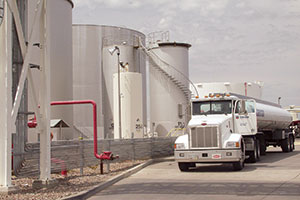Senior Reporter
US Diesel Average Declines 1.3¢ to $2.485; Price Is $1.138 a Gallon Below Year Ago

The U.S. average retail diesel price fell 1.3 cents a gallon to $2.485, the third consecutive weekly decline, the Department of Energy reported Nov. 2.
The national average for trucking’s main fuel was cheaper by $1.138 a gallon from a year ago, when the price was $3.623.
Last week’s price is the lowest since Sept. 28, when the price was $2.476, DOE’s Energy Information Administration said after its weekly survey of fueling stations.
One fleet executive said that, despite the trend of significantly lower prices compared with a year ago, reducing the variables in the cost of fuel remained an important concern.
Trucking’s main fuel price fell in every region of the country, except in the lower Atlantic, where it remained the same at $2.396. The Midwest price showed the steepest decline, falling 2.4 cents.
In California, however, diesel rose 0.4 of a cent.
Gasoline also dipped 0.4 cent to $2.224 a gallon. That slide followed a 4.9-cent decline the prior week. The price of gasoline fell in all regions except the Midwest, where it rose 4 cents.
Crude oil futures contracts for West Texas Intermediate remained below $50 a barrel on the New York Mercantile Exchange, closing at $46.14 on Nov. 2.
EIA also said in a report released Nov. 4 that U.S. crude oil inventories of 482.8 million barrels, not including the Strategic Petroleum Reserve, remain near levels not seen in the past 80 years for this time of year.
Even with a steady flow of comparatively less expensive fuel, its cost is something that requires close attention, said Stephen Normandin, director of strategic initiatives at Braun’s Express Inc., a Hopedale, Massachusetts-based less-than-truckload operation.
Normandin said the fleet buys 37,000 gallons of diesel per week companywide.
The company’s fleet of 175 heavy-duty trucks receives fuel from several vendors. Some fill bulk tanks, others offer onsite fueling services and Braun’s uses fleet fuel cards in its smaller truckload operation.
He said the fleet also specifies new trucks that are “as aerodynamic as possible” and has policies to reduce idling. “That way, independent of the pricing, the less cost basis you have in fuel, the better your profit margins are going to be.”
Plus, fuel surcharges are in place with company accounts to limit risk.
Still, Normandin said the carrier hopes to become more sophisticated in managing fuel costs.
“We have been looking into hedging our fuel prices,” he said. “We are not interested in speculating, but I think putting in some kind of hedge to smooth our fuel risks could be beneficial because [hedging] has more predictable cost margins.
“I’d describe the type of hedging I am talking about as trading in commodity options versus locking in a price over time, although that is basically the net effect,” he told Transport Topics.
Normandin said the fleet could turn to hedging in the near future.
“The goal is to keep the cost of fuel as consistent as possible regardless of the fuel prices. What you are paying for is the consistency and not having to worry about [fuel prices] as much,” he said.
Meanwhile, oil reserves could expand significantly in the years ahead, analysts said, as energy consumption increases, too.
The amount of oil and gas recoverable from known reservoirs could rise to 4.8 trillion barrels of oil equivalent through the application of existing technologies, compared with proven reserves of 2.9 trillion barrels currently, David Eyton, the group head of technology at BP, told Bloomberg News. Energy consumption will rise by 40% by 2035, and about 2.5 trillion barrels equivalent will be needed to meet global demand through 2050, he said.
New techniques developed in the United States to unlock oil and gas from shale formations have turned global energy markets on their heads, Bloomberg said. The nation reversed decades of decline to pump a record 9.6 million barrels of oil in June, contributing to a crude-price slump of almost 60% since June 2014.




